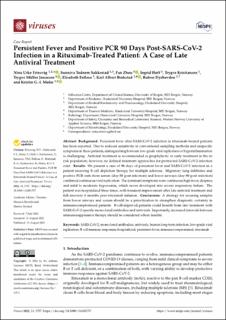| dc.contributor.author | Ertesvåg, Nina Urke | |
| dc.contributor.author | Sakkestad, Sunniva Todnem | |
| dc.contributor.author | Zhou, Fan | |
| dc.contributor.author | Hoff, Ingrid | |
| dc.contributor.author | Kristiansen, Trygve | |
| dc.contributor.author | Jonassen, Trygve Müller | |
| dc.contributor.author | Follesø, Elisabeth | |
| dc.contributor.author | Brokstad, Karl Albert | |
| dc.contributor.author | Dyrhovden, Ruben | |
| dc.contributor.author | Mohn, Kristin Greve-Isdahl | |
| dc.date.accessioned | 2023-03-16T12:57:53Z | |
| dc.date.available | 2023-03-16T12:57:53Z | |
| dc.date.created | 2022-10-19T10:53:06Z | |
| dc.date.issued | 2022 | |
| dc.identifier.issn | 1999-4915 | |
| dc.identifier.uri | https://hdl.handle.net/11250/3058801 | |
| dc.description.abstract | Background: Persistent fever after SARS-CoV-2 infection in rituximab-treated patients has been reported. Due to reduced sensitivity in conventional sampling methods and unspecific symptoms in these patients, distinguishing between low-grade viral replication or hyperinflammation is challenging. Antiviral treatment is recommended as prophylactic or early treatment in the at-risk population; however, no defined treatment approaches for protracted SARS-CoV-2 infection exist. Results: We present a case of 96 days of persistent fever and SARS-CoV-2 infection in a patient receiving B cell depletion therapy for multiple sclerosis. Migratory lung infiltrates and positive PCR tests from serum (day-58 post infection) and lower airways (day-90 post infection) confirmed continuous viral replication. The dominant symptoms were continuous high fever, dyspnea and mild to moderate hypoxemia, which never developed into severe respiratory failure. The patient was hospitalized three times, with transient improvement after late antiviral treatment and full recovery 6 months post-rituximab infusion. Conclusions: A strategy for securing samples from lower airways and serum should be a prioritization to strengthen diagnostic certainty in immunocompromised patients. B-cell-deprived patients could benefit from late treatment with SARS-CoV-2-specific monoclonal antibodies and antivirals. Importantly, increased intervals between immunosuppressive therapy should be considered where feasible. | en_US |
| dc.language.iso | eng | en_US |
| dc.publisher | MDPI | en_US |
| dc.rights | Navngivelse 4.0 Internasjonal | * |
| dc.rights.uri | http://creativecommons.org/licenses/by/4.0/deed.no | * |
| dc.title | Persistent Fever and Positive PCR 90 Days Post-SARS-CoV-2 Infection in a Rituximab-Treated Patient: A Case of Late Antiviral Treatment | en_US |
| dc.type | Journal article | en_US |
| dc.type | Peer reviewed | en_US |
| dc.description.version | publishedVersion | en_US |
| dc.rights.holder | Copyright 2022 The Author(s) | en_US |
| dc.source.articlenumber | 1757 | en_US |
| cristin.ispublished | true | |
| cristin.fulltext | original | |
| cristin.qualitycode | 1 | |
| dc.identifier.doi | 10.3390/v14081757 | |
| dc.identifier.cristin | 2062674 | |
| dc.source.journal | Viruses | en_US |
| dc.identifier.citation | Viruses. 2022, 14 (8), 1757. | en_US |
| dc.source.volume | 14 | en_US |
| dc.source.issue | 8 | en_US |

